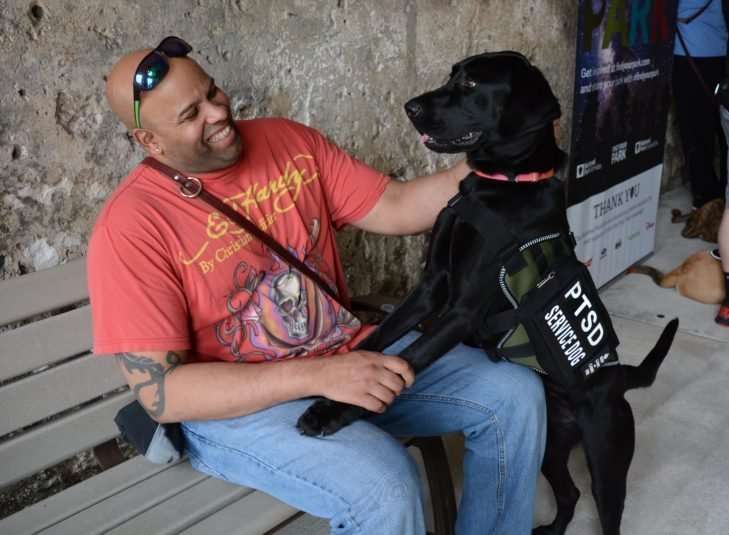All About Assistance Dogs
- January 22nd 2023
- Nature
- Animal Control animals dogs Sanford Police Department

Service Dog – Therapy Dog – Emotional Support Dog – Comfort Dog ???
by Lauren Masellas, Animal Control Officer, Sanford Police Department
The terms “service dog,” “therapy dog, “comfort dog” and “emotional support dog” are tossed around regularly, but are often vague and misunderstood. In what may be a rather lengthy discussion, I am going to attempt to unravel the mystery of the Service or Not Service Dog conundrum! First let’s get the term “dog” out of the way, because that’s the easy part. For the purposes of this article, I am going to use the term dog. I am aware that there are options as to species for some of the categories I will be covering. But for the sake of simplicity, I am using the term dog as that is currently the only species recognized by the Americans with Disabilities Act for service animal use. I will also disclose that the definitions I will be using are abbreviated. The following information was gleaned from Assistance Dogs International, Inc. (assistancedogsinternational.org) “a worldwide coalition of not-for-profit programs that train and place Assistance Dogs.” For more detailed information, please visit their website.
There are a myriad of specialized service dogs nowadays, and this list could very well miss a few. But it’s a good representation to get the conversation started at least. Since Assistance Dog is just a broad heading that covers most dogs trained to assist a person in a variety of capacities, let’s just go alphabetically!
Alert Service Dog: just what it sounds like. These dogs are trained to alert the handler to the onset of a pre-determined medical condition such as a seizure, diabetic crisis or mental health event.
Emotional Support Dog: notice the lack of the term “service” here. This is a companion animal that provides emotional/therapeutic support to individuals with diagnosed mental health or emotional health conditions simply by being present. No specific training is required and they are not classified as service dogs under ADA guidelines.
Facility Service Dog: Here there are two categories. The Courtroom Dog which is trained to function quietly within a courtroom environment to provide a comforting influence on vulnerable people during the investigation/prosecution of crimes and other stressful legal proceedings. The Facility Dog which is specially trained to work in clinical settings such as hospitals and mental health practices. This dog specializes in specific or skilled tasks in a variety of situations with different handlers and/or clients.
Guide Dog: (note the lack of “service” in their title, these dogs pre-date the term) trained to guide a blind or visually impaired handler through daily activities.
Hearing Dog: (note the same as above) trained to alert their deaf or hearing impaired handler to specific sounds such as the phone or doorbell.
Response Service Dog: trained to provide safety to a handler experiencing a medical episode such as guiding them to lay down at the onset of a seizure. Often co-trained as an Alert Dog.
Psychiatric Service Dog: trained to mitigate a mental health disability such as PTSD. They will alert the handler of people coming from behind them or in blind spots. They can help mitigate potentially startling activity in the area. They will alert the handler that an anxiety or panic attack is imminent and comfort them in a way that helps alleviate the crisis.
Sensory Service Dog: trained to assist handlers with autism. They can alert the handler to potentially harmful repetitive movements, ease overwhelming situations by providing deep pressure therapy or even guide their handler away from an overwhelming environment.
Service Dog: A general term for most of the above listed as well being trained to perform specific tasks for the disabled such as pulling a wheelchair, retrieving dropped objects, bracing, assisting in a medical crisis.
Therapy Dog: companion animal trained to provide affection, comfort and love to those it interacts with in many different settings. Often taken to hospitals, nursing homes and such. Different from the emotional support dog in that they are trained to work in different environments with multiple clients.
The presence of a dog for protection, personal defense, or comfort does not qualify that dog as an assistance dog. In fact protective, aggressive behavior is a disqualifying factor for any service dog.
Emotional Support Dogs, comfort dogs and most therapy dogs are not considered service dogs and are not granted public access under federal law.
So what are the public access laws? These laws are generally found under the Americans with Disabilities Act (www.ada.gov) and apply to Guide Dogs, Hearing Dogs and Service Dogs. They cover:
- Dogs Only
- Any breed or size is acceptable
- Trained to perform a task directly related to a person’s disability
They are not:
- Required to be certified or go through a professional training program
- Required to wear a vest or ID indicating they are a service dog
- For emotional support/comfort/protection
Service dogs are granted public access to businesses, hospital, schools, etc. They are also covered against discrimination in housing under The Fair Housing Act and travel under the Air Carrier Access Act.
A business is limited in what it may ask to determine if a dog is a service dog. They may only ask:
- Is the dog a service dog required because of a disability?
- What work/task has the dog been trained to perform?
They may not ask to see documentation that the dog is licensed, certified or registered as a service dog. They may not require the dog to demonstrate its ability to perform a task or ask the handler the nature of their disability.
There are, of course, exceptions to every rule such as a business that can demonstrate allowing a dog in would “fundamentally alter” the business. A zoo not allowing dogs into an area where the wild animals may be overly sensitive to a predator species in close proximity is a good example.
Businesses may also have a dog removed if the handler is not keeping the dog under control. Dogs that are barking, urinating, behaving unruly or aggressive may legally be asked to leave if the handler cannot bring them under control.
Service dogs may not “ride in the grocery cart,” be off leash or away from their handler (with few exceptions). They may be carried if their task is to alert for certain conditions such as diabetes or seizures otherwise they should be on the floor at their handlers side.
We’ve all seen it. The “service dog” that is barking/whining, in the seat of the grocery cart, halfway up the aisle on a retractable lead (not retrieving an item for its handler) or constantly pulling on the leash, jumping on people or worse, growling at a passersby…these are clearly NOT trained service dogs!
As you can discern from the list above, many service dogs are used for “invisible” disabilities. Consequently, it is impossible to look at a handler/dog team and determine if they are “really disabled”. Sadly, the increase in “fake service dogs” has created some prejudice against service dogs and their handlers in general.
That said, if you do encounter a service dog in public (the impeccable manners and working attitude is a good clue!), please respect that the dog is working. It is important to avoid distracting the dog from his duties no matter how adorable he may be. These amazing dogs have spent their entire lives training and working to provide an invaluable service and freedom to the millions of people with disabilities! RESPECT!







